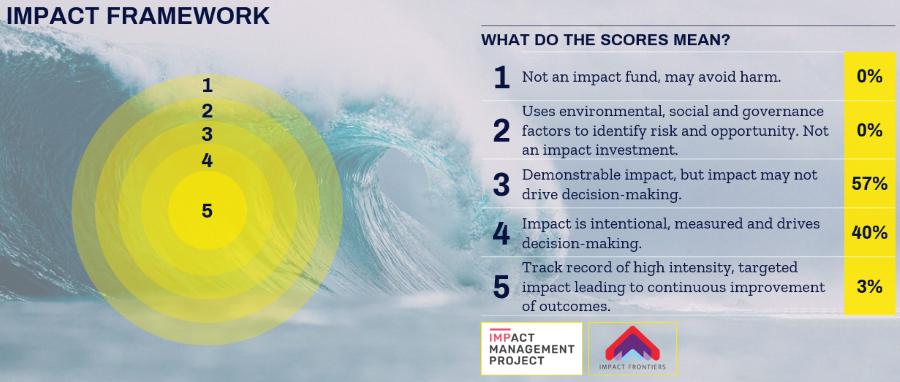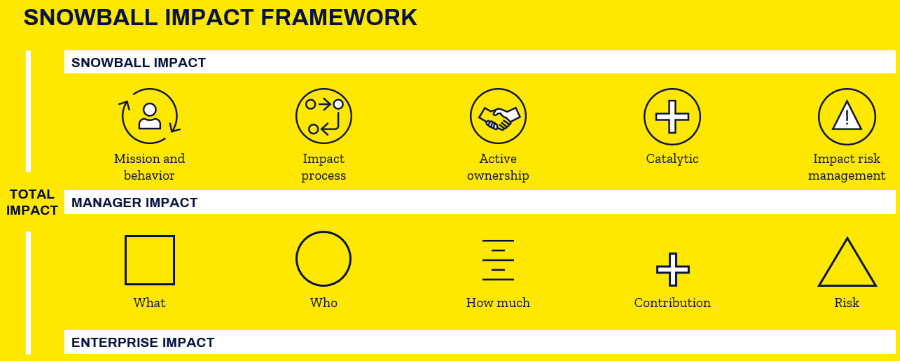Snowball bullseye and our approach to understanding impact intensity.
May 13 2022 · 6 minute read
We’re often asked about our bullseye score and how we can compare the impact of such diverse investments. We have a diversified, multi-asset portfolio which we look to optimise for risk, return and impact. This isn’t easy. Whilst comparative measures of risk and return are relatively well established, this isn’t the case for impact. It is particularly challenging for us given the breadth of our portfolio, which ranges from housing for those at risk of homelessness to cleantech venture capital. In fact, it’s incredibly hard to compare these in a meaningful way.
Doing impact right matters to us, so we’ve developed an in-house methodology to calculate the impact intensity of each investment we make, we call this the bullseye score. The score for each fund is then weighted by the size of each investment to come up with the score for the portfolio as a whole. We score our investments on a scale of 1 to 5: 1 being old fashioned ethical fund that uses negative screening to avoid harm, 5 being a fund with a track record of high intensity impact leading to improved outcomes.

The bullseye score for our portfolio currently stands at 3.5. We are transparent about this, publishing it each quarter in our factsheet; this enables a healthy conversation with our LPs and means they can hold us to account. Our ambition is to drive the score to the centre of the bullseye to maximise the impact of our portfolio. We can do this in 2 ways, first by investing in the most impactful managers which meet our risk return target; and secondly working with our managers to help them improve their impact over time.
So how do we actually calculate the bullseye score?
Our bullseye framework has 2 levels: firstly, the manager impact and secondly, enterprise impact.

MANAGER IMPACT
Starting with the manager impact, we assess each fund manager against the 5 categories shown on the slide. This builds on best practice such as the IMP Investor contribution strategies.
+ Mission and behaviours
Is the manager mission-driven, open and committed to learning and improvement – with impact at its core? We want to know if the managers assets are all invested for impact and if it lives its values – for example, is the manager a B Corps with protection in place against mission drift?
A manager which scores well in this area is Ananda Impact Ventures. We recently invested in their fourth impact venture fund. We believe that Ananda walks the walk when it comes to impact, for example, their carry is tied to impact, they have an impact term sheet for each investee which includes the company’s mission statement, and an independent advisory committee which signs off on KPIs and targets. If you want to learn more about Ananda Impact Ventures read our blog Ananda: Explore the portfolio.
+ Impact process
We want to know the manager’s impact thesis and whether it has a robust process to assess and measure impact. Crucially, we also look at whether the impact data is actually used to improve outcomes, something which is often overlooked. Otherwise, what is the point in collecting the data?
+ Active ownership
We look at how a manager engages with its investees. This differs depending on the asset class. For our venture capital managers, we expect them to support their investees to scale, often by taking board seats, making useful introductions and helping to build out the team. We hope this also involves helping build the company’s ESG and impact practice, so it is embedded in the company’s DNA as it grows and continues following exit.
For public equity managers, we are interested in how they engage with their investees and escalate issues, including voting against management or even ultimately selling a position. To assess whether an investment is catalytic, we look at whether the investment is growing new markets, field building or unlocking wider systems change.
+ Catalytic
Our recent investment into Resonance’s Women in Safe Homes fund is an example of an investment we would consider catalytic. The fund provides residential and refuge accommodation to vulnerable women, such as those experiencing homelessness, survivors of domestic abuse or prison leavers and is believed to the world’s first gender-lens property fund. It is particularly innovative as the manager is employing a new lease structure that is a half-way house between the needs of the charity partner and the investor to share risk in a fair way. If you want to learn more about why we invested in WISH read our Investment director Abigail Rotheroe being interviewed on impact investing contributing to solutions to women’s homelessness by Resonance's Social Impact Fund Manager on gender-lens investing Sarah Haynes here.
+ Impact risk management
This assesses the manager against a number of criteria such as whether we believe it can execute and whether its strategy is an efficient use of capital.
ENTERPRISE IMPACT

Enterprise impact is more straightforward, assessing an investment against the IMP 5 dimensions of impact. People may be familiar with these already so I will just touch on them briefly.
The 5 dimensions look at (i) “what” outcomes the enterprise is contributing to; (ii) “who” the stakeholders are and how are underserved they are; (iii) “how much” impact through the breadth, depth and duration of the outcomes; (iv) “contribution” looks at the impact against the status quo; and (v) “risk” tells us the likelihood that impact will be different than expected.
We score each underlying investment a manager makes against the 5 dimensions. For example, we have scored the enterprise impact of each of the 29 impact bonds in Rathbones’ portfolio. This gives us a real sense of whether a manager is delivering what it set out to do, and we may challenge the team if we think some investments are not in line with their impact thesis.
The manager impact score and enterprise scores are then combined to give a bullseye score out of 5, which represents the impact intensity of an investment. We have published two reports Managing for Impact: What we have learnt and what comes next and The Investor’s Perspective: Building an impact management process for a multi-asset class portfolio, which go into this in more detail. We are working on a third impact report which covers the Snowball impact which sits above the manager and enterprise impact.
If you have any questions on our impact framework please email hello@snowball.im.
